Learning Objectives
- Listening Growth
- Landscape & Diversity
- How to Find Podcasts
- Humble History
- Podcast Trends
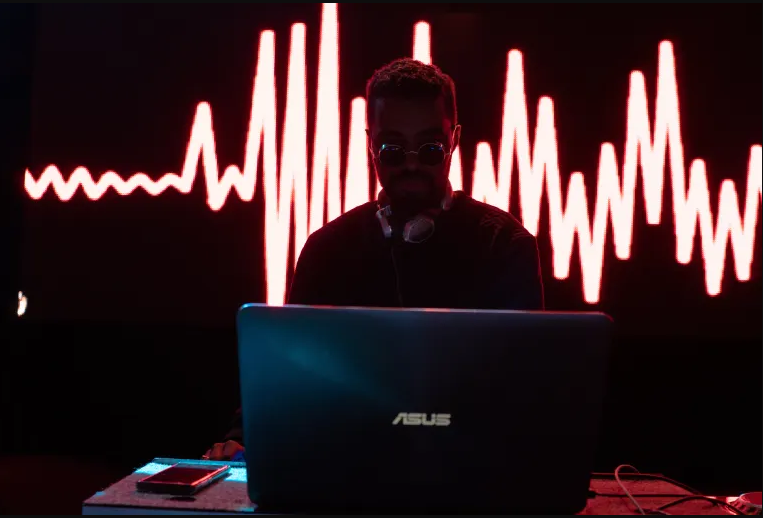

In 2025 the number of Americans listening to podcasts and online audio hit new all-time highs, with 73% of the population ever having consumed a podcast, or some 210 million people. The growth is driven by increases in podcast consumption – meaning both audio and video podcasts.
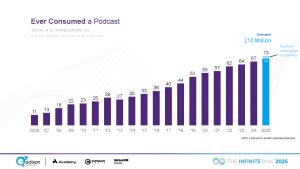
The listening figures come from Edison Research’s Infinite Dial which has tracked digital media consumer behavior and technology use for 27 years. A January nationwide telephone survey conducted in English and Spanish called both cell phones and landlines.
Listeners spent more time with podcasts than ever before in both weekly and monthly podcast listening, with the term ‘podcasting’ now familiar to three-out-of four Americans, narrowing the gap between familiarity and listening.
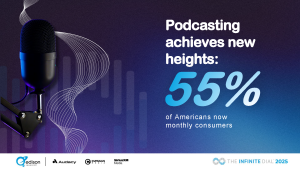
Other researchers say these numbers may actually be low as some podcast consumption involves co-listening, which is not counted in traditional podcast metrics. This occurs because of in-room smart speakers and in-car listening with friends, family and kids. The report comes from Cumulus Media and Signal Hill Insights.
With the push to video podcasts particularly by Spotify and YouTube, video has become a bigger player in podcasts, but is still far from dominant.
Infinite Dial has now expanded their surveys about podcasts to include video consumption. It shows that while video podcasts helped bring in about eight million more podcast consumers, it does not kill audio podcast listening. Instead, it provides another choice as consumers use both platforms.
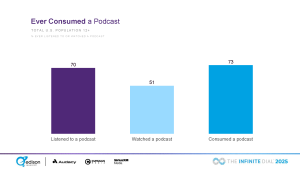
If you further break down the numbers for Americans 12 and older, 70% have listened to a podcast, while 51% have watched, and with the overlap that adds up to 73% of the population having consumed a podcast in either audio or video or both.
Edison Research Vice President Megan Lazovick points out that most people who watch podcasts will say they are podcast listeners. “But as more people discover the platform via video, it’s smart to think about it as consumption, instead of just listening.” She says that while this is not intended to undercut the magic of audio-only content, “there’s room for both video and audio in the world of podcasting.”
For the younger demographic, podcast reach is now as big as TV. Podcasts are replacing traditional media consumption with not only less TV watching but less time browsing social media and playing video games, according to research and consultancy firm KS&R.
The growing number of video podcasts is also impacting gender. While the early days of podcasting were dominated by white male listeners, the gap between male to female listening had been leveling out in recent years. Now, due to a strong male video podcast base, there’s been an increase in men who watch and listen but not in women.
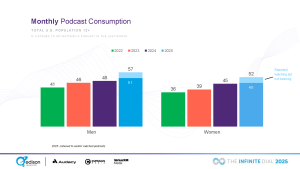
Podcast watching is especially big among the younger demographic of 12-34 years, as well as for those 55 and older, leaping in the past year from 27% to 38% in 2025. However, in many cases the video is minimized and only playing in the background.
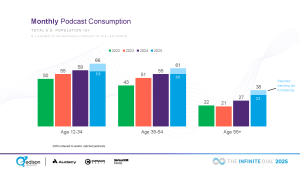
Politics also helped fuel podcast listening during the recent election year for both major political parties, accompanied by a significant change in consumer behavior. In 2022 more Democrats listened, but now Republicans have surged ahead with an increase in conservative talk podcasts.
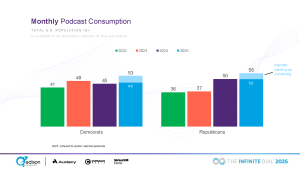
In the U.S. where you live also makes a difference in listening patterns. Urban audiences spend over twice as much of their daily audio time with podcasts as rural listeners, acccording to Edison’s Share of Ear study.
This chapter gives an overview about the landscape of podcasting, who’s doing it, what researchers have discovered about audiences, and identifies top trends.
There’s also been an increase in racial diversity with the number of Black and Hispanic podcast listeners increasing over 30% in the U.S. in recent years.
The largest demographic group of listeners is Gen Z (those born between 1997-2012), according to a study from Sounds Profitable. While most began listening as teenagers, a good number started as children, and they are racially diverse.
They mostly discover podcasts from social media and eight-in-ten monthly listeners say they don’t do anything else when they listen to podcasts, according to an Edison report.
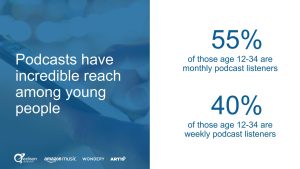
Young people also dominate when it comes to podcast creation. In terms of age, the largest number of creators are in the 25-44 age group, while those in the 55+ demographic barely exist. This can be an opportunity for both creators and advertisers.
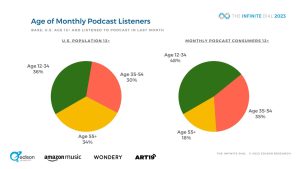
The Black Podcast Listener Report from Edison Research says that 43% of the Black population in the U.S. has listened to a podcast in the last month. Black females are more likely to be monthly listeners while Black men are more likely be weekly listeners.
It’s clear that representation matters as more frequent listeners follow or seek out content that focuses on Black stories and perspectives. Younger listeners are more likely to listen to shows hosted by Black hosts. The Black-owned news aggregation app, Hayti, is the largest source for podcasts with Black hosts, offering access to over 2,000 Black hosts.
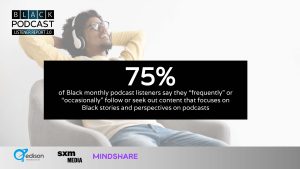
Video is also a strong attraction for Black podcast listeners (80%), as they like to see representation.
Podcast listening among Latinos has increased by 52% since 2020, nearly four times faster than the rate of the general U.S. population.
Edison’s fourth annual Latino Podcast Listener Report says that 38% of U.S. Latinos are monthly podcast listeners, a record high estimated to be 17 million Latino adults who live in the U.S. They are more likely to be employed, earn a higher income, and are more likely to be entrepreneurs.
They are listening in both English and Spanish.
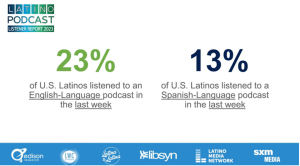
Past surveys have also shown that video draws in high numbers of Latino podcast listeners (76%), with a large number first introduced to podcasts because of YouTube.
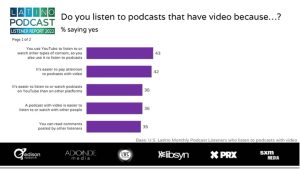
IHeart Media, the largest radio station group owner in the U.S. has a partnership with the Latino Oyénos audio network to distribute dozens of Hispanic-focused podcasts on the IHeart platform.
In Latin America there was a podcast boom in 2019, due to large investments in programming by Spotify which at one time owned 90% of the market. But the company has reversed course the last few years and canceled shows and had large layoffs. An investigative reporter in Bogotá, Columbia traced the shake-up.
In ethnicity, the number of podcast creators is more in line with the overall U.S. population for Whites, African Americans, and Asians, while Latino creators are growing significantly.
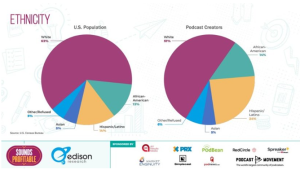
The data on education levels for creators does not look like the average American since 40% of creators have an advanced degree, which leads to higher levels of employment and higher income. Analysts point out that this makes the creator class more privileged than the general public, which can impact content creation.
All these numbers can be overwhelming but it’s useful to know some of these metrics as a way of understanding the birth and growth of the podcasting industry.
Podcasts already have considerable reach among kids 6-12 in the U.S., according to the Kids Podcast Listening Report by Edison Research.
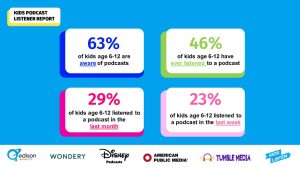
Forty-six percent have ever listened to a podcast, and 29% of ages 6-12 in the U.S. listened in the last month. That percentage soars to 42% if their parents listened to a podcast in the last month.
Kids listen because they think podcasts are fun to listen to and a way to avoid boredom, with the top genres being games, music, adventure, comedy, short stories, and bedtime stories such as those from Sleep Tight Stories. For parents, podcast listening is a way to connect as a family as they listen together and discuss. The national online survey of parents was administered by parents and in-home interviews.
In the U.S. and around the world there is a rise of child podcast superstars, with pre-pubescent hosts 13 years of age and younger.
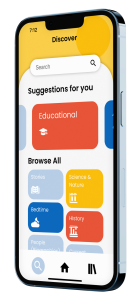
KidsPod is an app for children 3-13 years of age with both free and paid subscriptions, developed with a kids’ tech expert. Co-founder Rachel Lacy says kids, just like parents, like to multitask while listening, “making podcasts more interactive helps audio compete with streaming and gaming when kids do have a device in hand.”
Worldwide the average number of podcasts consumed monthly has grown from a quarter to about a third (35%), according to the 2024 Digital News Report and attracts a younger and better-educated audience. The survey covers six continents and 47 markets in a study commissioned by the Reuters Institute for the Study of Journalism.
According to the study the highest reach among the 20 countries surveyed shows that nearly half of respondents in the U.S. and Spain reported listening to a podcast in the past month, with listening the lowest in Japan.
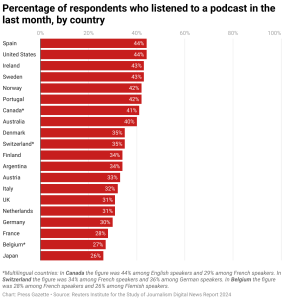
The smartphone is the most popular way to hear a podcast, although some listeners do download shows to their computer. Taking information from OP3 – the free, open podcast analytics service, Podnews created a graphic that shows Spotify as the dominant app for most of the world, while Apple is the biggest app in the U.S. The United Kingdom uses more independent podcast apps than any other large country.
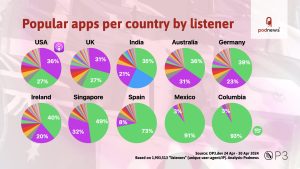
You can filter apps by platform: iOS, Android. All podcast apps all have a library of podcast shows categorized alphabetically or by genre.
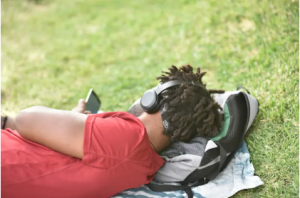
In podcast listening, use an open podcast app that supports Podcasting 2.0, which seeks to standardize and improve delivery of podcasts to all audiences and not just those who have paid for access. They include:






Hosting services that support Podcasting 2.0.
Podnews has a list of host services and how to add your podcast to every podcast directory.
In all, the number of podcasts is considered to be between two to five million. The differing numbers reflect the podcast directory being used.
Podcast Index, which is primarily built from discovering open podcast RSS feeds on the web, says there are more than 4 million podcasts.
The Apple Podcasts catalog lists nearly 3 million podcasts while Spotify says they have more than 5 million podcasts, reported by Podnews.
While it may seem like there are too many podcasts competing for ears and eyes, many of the large numbers of podcasts created during the pandemic years are no longer in production. By July 2024 the number of active podcasts – meaning that a new episode has been released in the last 90 days – dropped to 13.4%, according to figures from PodMatch.
Most significantly, more than half of all that listening now happens on YouTube and Spotify combined, with one-third using YouTube followed by a quarter on Spotify, according to a survey by Cumulus Media and Signal Hill Insights.
Overall in 2024 people listened to an average of 8 podcasts a week, with females listening even more, according to Edison Research.
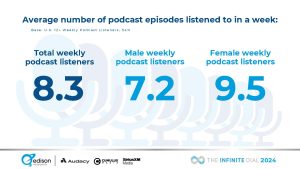
Hard-core listeners consume 12 or more podcasts a week, while medium listeners hear three to six podcasts weekly and the casual listener one to two shows.
Podcast “super listeners,” spend an average of 11.2 hours listening to podcasts weekly, up from previous years. Over half of this group listen to podcasts through YouTube, often discovering new podcasts through the platform.
In the U.S. the most popular genres are Comedy, Society & Culture, News, and True Crime, followed by Sports and Education.
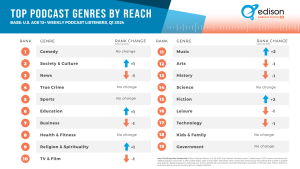
In particular, Gen Zer’s, value diverse podcast content and the importance of mental health with a focus on self-care and unplugging.
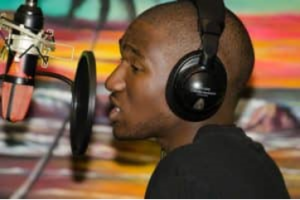
Among the overall audience, listening to the True Crime genre remains immensely popular with shows regularly at the top of podcast charts, spurred by the phenomenal success of Serial. Some cover cold cases and unveil family secrets while others bring publicity to underrepresented communities, looking for justice.
Criminologists say interest in true crime is driven by the basic human emotion of fear, allowing people to experience fears without the consequences of actual trauma. Rolling Stone came up with a list of “The best 25 True-Crime Podcasts of All-Time.”
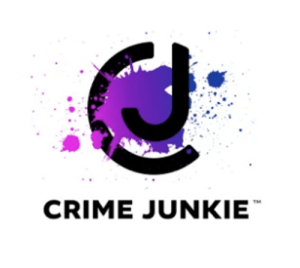
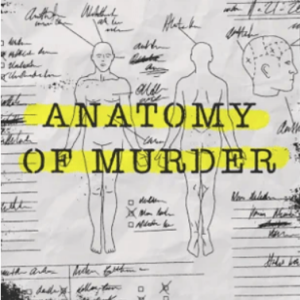
In a similar vein, investigative podcasts may involve true crime but they also run the gamut – terrorism, corporate or political scandals, health care, or inequality in education.
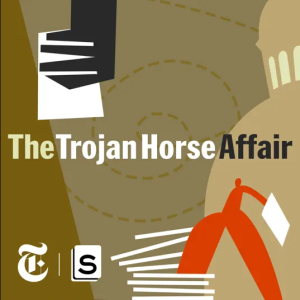
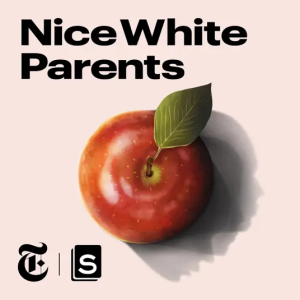
Both genres are expensive to produce and time-consuming to create because this kind of watchdog journalism can take weeks, months and even years to come to fruition. “I believe investigative journalism is really like you are solving a mystery,” said LA Times reporter Joanne Faryon.
The Investigative Reporting Workshop (IRW) at American University in Washington, D.C., has a look at how investigative reporters develop their stories for audio.
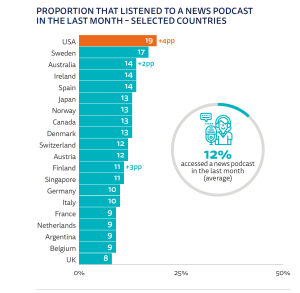
Globally, the number of news podcasts has increased and several regularly rate at the top of podcast charts according to a 2023 Pew Research Center Report.
One-in-three adults ages 18 to 29 listen at least sometimes to get news from podcasts, making them the largest demographic listening group. But more than half of Americans (56%) say they never get their news from podcasts, which means there is still significant growth potential.
While just one-in-five U.S. podcast listeners listen to podcasts from a news organization, the legacy media organizations have put money, time, and staffing into news podcasts – from audio organizations such as NPR to national publications like The New York Times which is building an audio empire by buying audio companies and adding more podcasts.
The Pew survey found the most popular news-related podcast format to be when a topic in the news is explained in depth (57%), followed by a host offering opinions (53%), or a summary of the major news stories of the day (51%). “Most consumers are looking not for more news, but news that feels more relevant, and helps them make sense of the complex issues,” says the report.
The massive success of The Daily from The New York Times, is credited with driving the growth of news podcasts, which attracts a younger and better-educated audience than traditional media. Since being launched in 2017 the powerhouse explanatory podcast has been downloaded more than 3 billion times with some 20 million people listening monthly. The format is to take one big story and explain the issues in depth in for 20 to 40 minutes.
The Wall Street Journal reported that the Times would start putting up a paywall for audio but it would be limited to old episodes while new shows would continue to be free.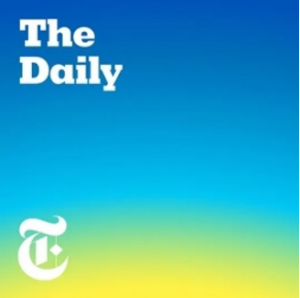
The Times launched a shorter daily news podcast in 2023 that covers three top stories in about 10 minutes. The Headlines can be heard on New York Times Audio, an iOS app for subscribers. In addition to podcasts, the app will have audio features curated by Times journalists.
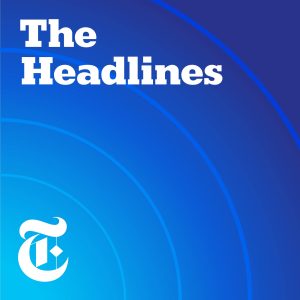
Among competitors, The Washington Post offers The 7, which explores seven or more important or interesting news stories of the day with reporting and insight in about a 10-minute time span, while Reuters World News has a 10+ minute news briefing and the BBC has a 15-minute news podcast, aimed at 16-24-year-olds around the globe.
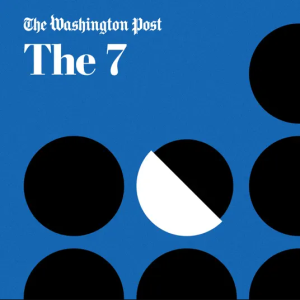
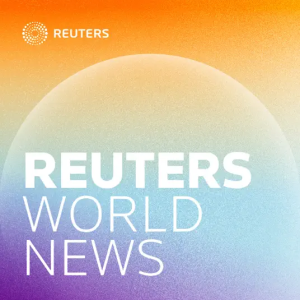
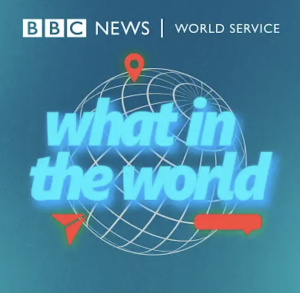
Also topping the podcast charts are two NPR news podcasts. Up First is the daily news podcast discussing the three biggest stories of the day with reporting and analysis in 10 minutes. NPR News Now has the latest hourly news in 5 minutes.
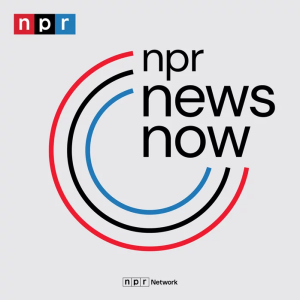
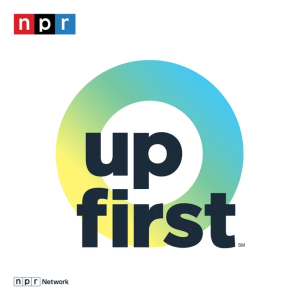
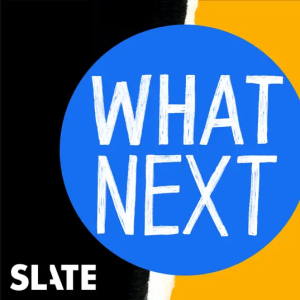
In the best news podcast category, Vox’sToday Explained won the 2024 Ambie for excellence in audio. The podcast covers the most important news of the day in about 30 minutes. The award comes from the professional member association, The Podcast Academy

News listeners generally view news podcasts as accurate, especially compared with news from social media. But there are danger signs ahead as the proportion of news consumers who say they avoid the news has grown sharply worldwide because consumers feel it has a negative impact on their mood and because of concerns over false and misleading news.
Podcasts are now recognized at the highest levels of excellence in American journalism, with prizes that include the Pulitzer, Peabody, du Pont-Columbia Awards, and The Radio Television Digital News Association (RTDNA), among others.
Investigations have righted wrongs by getting inmates released from prison and exposed injustices that resulted in new national laws.
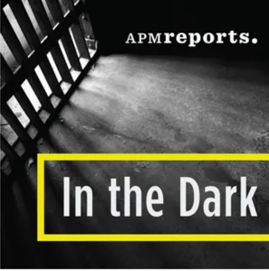
The U.S. Supreme Court felt the impact of a podcast in 2019. The In The Dark podcast prompted the U.S. Supreme Court to review and throw out the murder conviction of Curtis Flowers, a black Mississippi death row inmate who had been tried six times for the same crime.
A new trial was ordered after the investigative unit of American Public Media uncovered evidence of a pattern of racist jury selection by the prosecutor. After 23 years, Flowers became a free man after the Mississippi attorney general dropped state charges against him. The show also won top journalism honors including the Peabody, George Polk, and Edward R. Murrow awards.
Creation of the national sex-offender registries came after the 2016 podcast “In the Dark” documented how police mishandled the child abduction and murder of a small-town Minnesota boy.

The prestigious Pulitzer Prize Board added a new category for Audio Reporting in 2020.
2020: The first Pulitzer was awarded to “This American Life” for its reporting on the personal impact of the Trump administration’s “Remain in Mexico” policy.
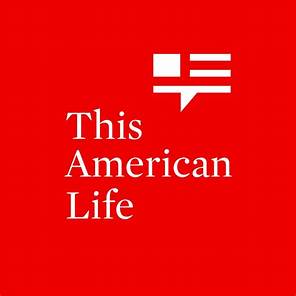
2021: NPR took home the second-ever Pulitzer for Audio Reporting for an investigative report about some Iowa-based gun rights advocates, looking at how two brothers used social media to try and eliminate gun regulations in America.
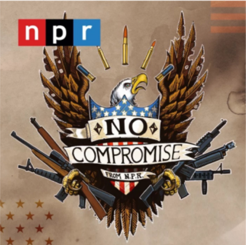
2022: A third Pulitzer was won for a podcast about juveniles sentenced to spend their whole lives in prison. Suave was produced by two non-profits, Futuro Media and PRX. The U.S. is the only country in the world that allows juveniles to be sentenced to life in prison without the possibility of parole and the podcast tells the story of one man’s redemption.
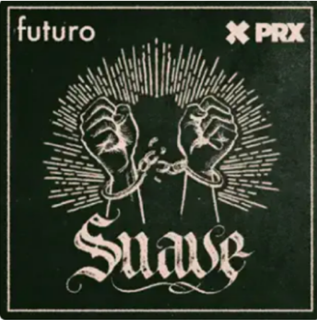
2023: Gimlet Media and journalist Connie Walker won the Pulitzer for audio reporting in a series that revealed the abuse of Indigenous children at an Indian residential school in Canada, Stolen: Surviving St. Michael’s.
For a behind-the-scenes look at how such stories come together, there is a six-episode podcast, Pulitzer on the Road, that talks with the 2023 winners in conversations with Pulitzer Board members.
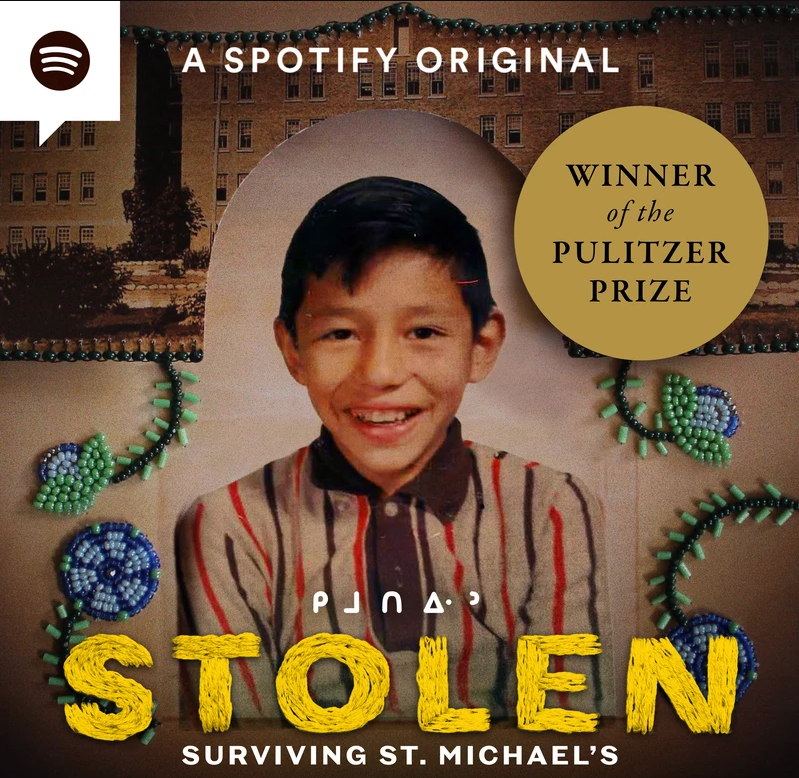
2024: The staffs of The Invisible Institute and USG Audio won the Pulitzer for You Didn’t See Nuthin, a series that revisits a Chicago hate crime from the 1990s utilizing memoir, community history and journalism. This same podcast was also awarded the Peabody Award, given to the “most compelling and empowering stories released in broadcasting and streaming media.”

2025: The latest Pulitzer for audio reporting went to the New Yorker’s In the Dark podcast, which chronicled a four-year investigation into the murder of 25 unarmed Iraqi civilians in Haditha, one of the most high-profile crimes of the Iraq War. Hosted by Madeleine Baron, the investigative-journalism podcast started in 2016 and joined The New Yorker and Condé Nast in 2023. This is the sixth Pulitzer won by an investigative journalism podcast since the audio reporting category was created in 2019.
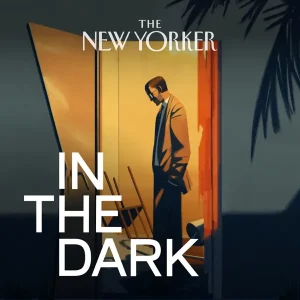
Other top awards:
The 85th Annual Peabody Awards recognized “stories that matter,” in news to entertainment programming. In the Radio/Podcast category there were four winners, including additional recognition for the investigative work by The New Yorker.
In the Dark: The Killings in Haditha, also won this year’s Pulitzer Prize.
Blindspot: The Plague in the Shadowsblid focused on the solidarity of those within the AIDS crisis.

Pulse: The Untold Story uncovered how the 2016 Pulse nightclub shooting was politicized and initially portrayed as a hate crime but was instead the shooter’s opposition to American military actions in Iraq and Syria.
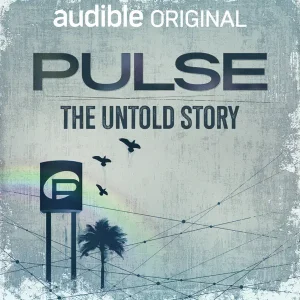
Yousef, Youmna, Banias, and Majd: Four Lives in Gaza, from This American Life, focused on the personal struggles of people in war-torn Gaza.
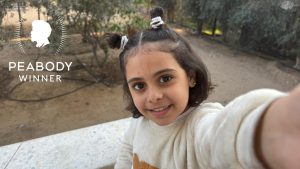
Previous Peabody Honors for groundbreaking investigative podcasts have gone to such podcasts as Serial, S-Town, and In the Dark.
It may seem like everyone has their own podcast since technology has made it possible to be your own creator and publisher – giving more people a voice to be heard. But it’s not just individuals who podcast, its institutions, government, business, the arts, religion, non-profits, and education.
The power and reach of the medium are so pervasive that the U.S. Library of Congress has its own podcasts and added podcasts to its archive “as part of its mission to collect and preserve sound recordings,” and is contacting selected podcasters to seek permission to add their shows.
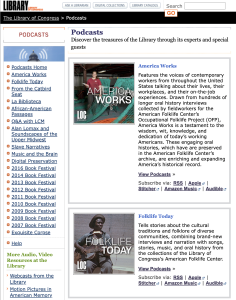
The Smithsonian’s storytelling got a boost from a partnership with PRX. Their podcast, There’s More To That, covers history, science, and culture with journalists from Smithsonian Magazine. Among the first episodes were the backstories of two blockbuster movies, Oppenheimer and Barbie.
In education podcasts play a variety of roles – encouraging student learning, creation of content, and allowing for greater access to information from the deep research done in academia. Students can download a podcast lecture to a mobile device and get 24-hour access. In today’s fast-paced world students will listen longer than they will watch or read and are able to go back over material they find difficult.
While some educators may want to keep their content restricted to enrolled students, other colleges and universities have created podcasts for public consumption. A wide variety of topics include business, medicine, law, the environment, enrollment, administration, and a number that feature academic research or revolves around academic stars.
“Deep Background with Noah Feldman” from Harvard explores the news from a historical, scientific, legal and cultural context. “View From The Top” is based upon a Stanford University Dean speaker series. Other podcasts feature students, such as “A Hard Look,” a podcast by the Administrative Law Review that I advised in their startup for the American University Washington College of Law.
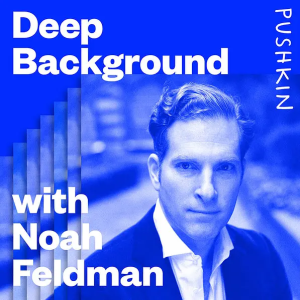
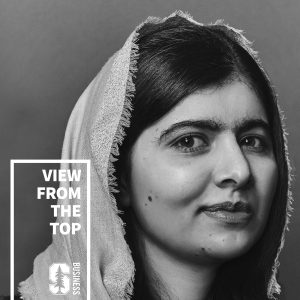
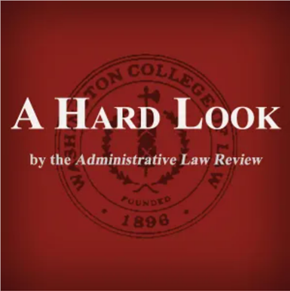
It’s now a bit easier to find the wealth of higher education podcasts in one place thanks to a new searchable podcast directory called “HigherEd Pods,” which lists hundreds of shows. The goal of the site is to build a higher education community for those involved in producing and marketing college podcasts.
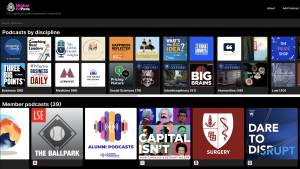
In addition, the “Continuing Studies Podcast” provides tips and best practices with a spotlight on university podcasters and conversations about admissions, alumni, and explaining concepts such as Podcasting 2.0 with podcast expert James Cridland, editor of the Podnews newsletter.
For students, NPR sponsors an annual podcast competition for middle and high school students (grades 4-12) and a separate competition for college students, with the winners stories put online.
For college students the Podcast Challenge time comes in the fall with a $5,000 grand prize scholarship and $500 prizes to finalists. In 2023 there were ten college finalists with topics about climate change, gender and identify, campus politics, and mental health, offering both sound-rich podcasts as well as strong writing and narration. The winner was a deeply personal narrative about a college student with a rare mental health condition. The competition opens again in September 2024 with a deadline for submissions in January 2025. No faculty involvement is required.
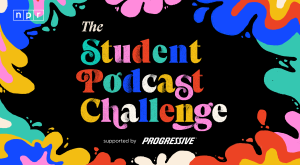
For younger students there were more than 3,300 entries from 48 states, the District of Columbia and Puerto Rico, on topics from what makes Michigan the best state, to trauma and school shootings. NPR determined 13 middle school and 13 high school finalists. The high school winner unpacked how the Jackson, Mississippi water crisis affected students and the community. The contest will reopen for entries in Spring 2025 and no teacher involvement is needed.
In the vast podcast ecosystem, companies offer their own branded podcasts as marketing and storytelling tools – creating a way to engage with listeners while also sharing brand information. The goal is not just selling products or services but to build brand loyalty by creating a bond with listeners. Quill has a white paper with case studies and measurement of brand podcasts.
Financial services giant like Charles Schwab, have podcasts with advice as well as a look at the political landscape for investments. Sporting goods company REI has podcasts with outdoor enthusiasts sharing their stories on ultrarunning, hiking and bike building and the Sephora Collection has chats about self-image and becoming more confident.
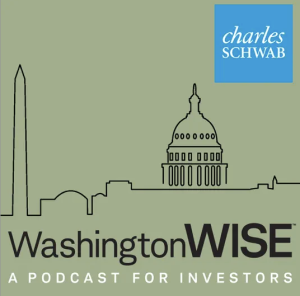

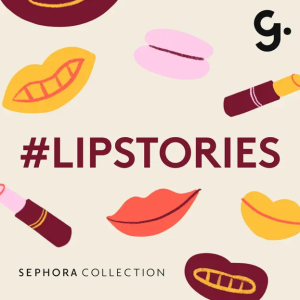
In addition, a number of businesses do internal company podcasts, which in some cases replace the company newsletter.
Companies use the podcasts to:
These private podcasts are done the same way as public ones, but businesses can restrict who has access. Content can be accessed on popular listening apps, but it’s not publicly displayed on Apple Podcasts, Google Podcasts, and others. The podcasting firm uStudio has seen its clients now produce an average of 10 podcasts using its platform, according to Digiday.
Identifying the top podcasts depends upon which metric is used since there is nothing like the “Top Billboard” chart for music or the Nielsen ratings for television.
When it comes to audience numbers you need to know how to read them.
In the podcast world there are analytics from podcast hosting services like Libsyn or Captivate, from third-party rankers such as Triton and Podtrac, and from podcast apps like Apple or Spotify.
The most complete data comes from podcast hosting services as they have data for all RSS platforms like Apple and Spotify, which has added ‘Listen Time‘ to their podcast dashboard. That is defined as the “the total number of hours people have spent listening to or watching your episode.”
Rankers like Podtrac publish a monthly list of Top 20 Podcasts and of Top 20 Publishers, based on downloads, while Triton does a weekly average. These podcast rankers are produced monthly on a per region or country basis.
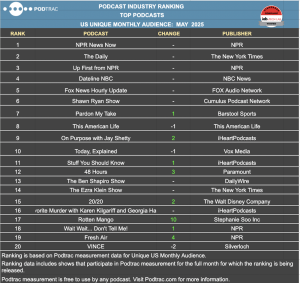
In contrast, Edison Podcast Research measures listening and not downloads across all networks, shows, and platforms. They publish quarterly reports of the top 50 podcasts in the U.S., the top podcast networks, top podcasts among women, among Black listeners, for new hits, and even for shows with the highest portion of their audience that listens exclusively.
A podcast app such as Apple Podcasts Connect, Spotify for Podcasters, or YouTube Studio measures only the data on their platform. More about audience measurement in Chapter 10.
The start of podcasting began with three people – a former MTV video jock, a software engineer who pioneered blogging and developed the web feed known as RSS, and a former journalist/writer.
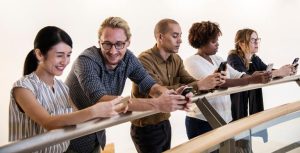
In 2001, media personality and entrepreneur Adam Curry, shared an idea in a blog post that led to podcasting. You can now see that post and learn the intriguing story of the first podcast feed, thanks to research by journalist and podcast creator Eric Nuzum.
Curry had met in a New York City hotel room with software engineer/blogger Dave Winer, the pioneer who created the tools that drove blogging and distribution technology. He posted about that meeting, “Adam wants the Internet to be Everyman’s broadcast medium, to route around TV and radio broadcast networks, with no compromise in quality. Now if this were easy, or the solution obvious, we’d already be doing it. But there’s a big sticky problem in the way, the pipes don’t seem big enough,” wrote Winer.
It wasn’t long before Winer had made the code changes to RSS that allowed for audio enclosures and the first podcast feed was released using one Grateful Dead song, which not many people heard. But it was the day when written word blogging moved over to distributing audio.
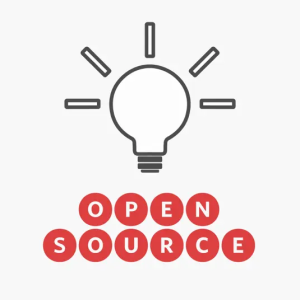
It took another two years for the first podcast by Winer and journalist Christoper Lyden, created after a blogger conference at Harvard University. It became what is now the world’s longest-running podcast, Open Source.
Podnews offers a history lesson on podcasting in the United Kingdom.
The word podcast comes from the word’s “pod” as in iPod and “broadcast.” It was in 2005 that the Oxford Dictionary named “podcast” as its word of the year after journalist Ben Hammersley coined the term the year before in the first major print publication. Podnews offers a look back at evolution of the word.
In the early days, podcasts mostly came from radio corporations such as NPR, looking for new ways to distribute audio programming. Traditionally, a podcast has been defined as a digital audio file available on the internet that can be downloaded on a computer or digital device and is automatically received by subscribers.
But today, listeners are discovering podcasts in multiple ways, including on YouTube and Facebook rather than podcast apps. While some believe the only true podcasts are downloadable audio, others say it has emerged today to be something more like a storytelling experience whether it be video or audio, or both.
It was the launch of “Serial,” that began the boom year for podcasting in 2014. The podcast shattered records at the time and has over 300-million downloads to date. The show was also the first podcast to win the prestigous Peabody Award, which rewards stories that matter.
In that first series, Sarah Koenig’s narrative podcast told a single non-fiction story over 12 episodes, using a narrator. The story was spun off from public radio’s “This American Life” and focused on the 1999 murder of a 15-year-old girl from Baltimore. Her former 17-year-old high school boyfriend, Adnan Syed, was convicted of the crime and spent 23 years in prison. However, the Serial podcast shined a light on the case, questioning evidence and the quality of legal representation.
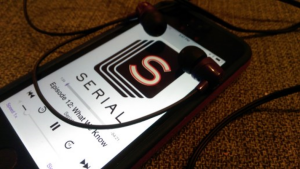
Then in another flip in the case, a Maryland appellate court reinstated the conviction in March 2023, deciding the victim’s family did not have enough time to attend a hearing case in person. In 2025 a Baltimore court ruled that Syed will not return to prison, despite the murder conviction, and reduced the sentence to time served. The sensational case that drew international attention is now officially over.
Serial is credited with opening the doors for other popular podcasts to be consumed by mass audiences in the so-called, “Serial effect,” especially in the True Crime genre. Vox has a retrospective on the role of Serial in the genre boom.
Podcasters are primarily using artificial intelligence to enhance workflow – to generate ideas, create transcripts and show notes, help with editing, create cover artwork, and for marketing materials. There are both free and paid services.
As the saying goes – just because you can do something doesn’t mean you should. The use of some AI tools is not entirely innocent and carries the potential for societal harm. Since artificial intelligence is built from already acquired data, when such information is flawed or incomplete, it ultimately results in reinforcing implicit and explicit bias. You can make up your own mind on whether of AI tools help or hurt the podcast industry but it’s well worth an ethical discussion.

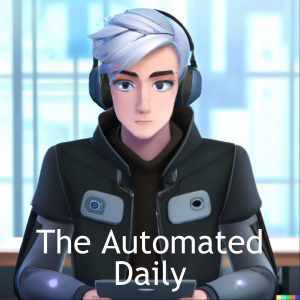
Podcasts that are entirely created by AI are here. Hacker News TLDR recaps headlines from Hacker News, the social media site on computer science and entrepreneurship, with shows running 13 to 20 minutes in length. The tech podcast, The Automated Daily, looks for news to generate headlines of the day. The host is named “Trend Teller” and show length is between 4 and 7 minutes, according to a sampling.
Written blogging can now be turned into podcasting thanks to a new feature being offered by leading podcast platform, Podbean. AI voices turn the blog into audio with a choice of up to five languages or countries. You can review and edit before publishing. Podbean has a community of over 640, 000 podcasts and the hosting service comes with a free podcast website. You can see how the new AI feature works here.
There are many AI tools to make transcripts and Apple and Spotify now have auto-generated transcripts, but creators should check for accuracy. OpenAI has a tool called Whisper to generate transcripts, including transcripts in multiple languages, as well as translation from those languages into English. Deepgram is a competitor and both are paid tools.
See Ch. 9 for free ways to make transcripts.
For visual appeal there is AI-generated art. Customers of publishing platforms like Blubrry can generate images, show titles and host names. Free and open-source AI art generators such as GIMP have image creation and Dream.ai generates images by turning your words into works of art.
However, copyright lawsuits have been filed against other AI art generators because they learned how to create art from images on the internet, without the consent of artists.
See Ch. 2 for tips on ways to create your own cover art.
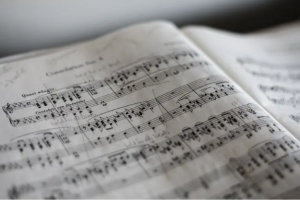
AI algorithms can improve sound quality by removing remove filler words like “um” and “like” as well as awkward pauses and remove background noise, making editing quicker and easier.
Some examples include:
Descript’s Overdub feature can correct mistakes in speaking and when a host mispronounces something by having AI say it correctly. The software allows you to edit video just like a word document and makes automatic transcripts. You can record and replace a section of audio or video using Replace Selection without interrupting the timing of everything else.
While there is no substitute for doing proper soundproofing before you record, if you still have hollow, muffled, tinny sound or background sound from air conditioning that you can’t turn off, there is a free AI tool you can try. I tested out Adobe Enhanced Speech and found it to be pretty good in removing noise but not always.
Several AI tools are in beta: Regenerate can be used to edit jumpy or abrupt edits or to get rid of sudden noises like a car horn or when a host lets their voice trail off; Eye Contact will rotate your eyeballs to make it look like you are looking directly in the camera even if reading a teleprompter or looking off camera.
More controversial AI uses include creation of entirely AI podcasts, script writing, use of cloned voices, and non-disclosure of AI use.
The human voice stands out for being trustworthy in podcasts and in radio. People are more than twice as likely to trust a human voice (55%) over AI-generated content (23%), according to Audacy’s Innovation Tracker (June 2024). That also extends to trust in advertising voices.
But, just like AI has built fake videos and lifelike images, voices of the dead as well those still alive have been cloned. In the documentary, Roadrunner, about the life of the late Anthony Bourdain, AI reconstructed three lines to sound like they were said by the celebrity chef-host, a technique not originally disclosed to the public. This technology means that the voice of a familiar podcast host, whether hosting a show or an ad, could actually be a voice clone.
Platforms like YouTube, Spotify, and Apple have now put rules in place about use of AI. Guidelines for podcast producers have been drafted in a Listener Bill or Rights about AI, by media company WaitWhat.
One advertising company, ADOPTER Media, has issued standards on voice cloning and AI audio use for host-read ads. “Using AI to read a personal endorsement—unless done for accessibility purposes—is both disingenuous and unethical.” The standards were designed to safeguard the integrity of host-read ads and trust in personal endorsements.
Nonconsensual use of AI voice clones is not only a monetary decision but involves ethical and legal issues. At least one podcast was already threatened with a lawsuit after AI generated content imitated the voice and image of NFL legend Tom Brady for the Dudesy podcast.
See Ch. 7 for tips on how to best use your own voice in podcasting.
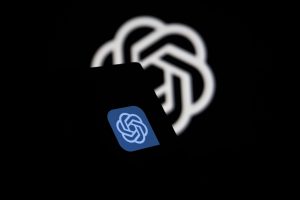
AI gave a boost to podcast discovery from Sounder and Podroll. By using these tools you can get personalized podcast recommendations based on listener preferences and behaviors to your next favorite episode, with preliminary data showing a 30% increase in podcast consumption.
For podcast planning and episode topic ideas there are several tools: the free tool ChatGPT or paid tools Jasper AI, and Showplanner can help a podcaster come up with topic ideas, research, guest ideas & interview questions, episode titles & outlines. See Ch. 2 for tips on doing it yourself and look to Ch. 5 for tips on interviewing.
Artificial intelligence has been around for 40 years, but when OpenAl’s ChatGPT launched in late 2022 it grew faster than TikTok and became the fastest-growing ‘app’ of all time. Google introduced Gemini technology and both platforms are in agreements with news companies about news and tech sharing. Microsoft has Copilot, which can automatically creating a PowerPoint presentation based on a word document.
Concerns over safety and risks from AI prompted the Biden Administration to meet with the most influential companies building AI. It resulted in a voluntary pledge to mitigate risks and to allow security experts to test systems before they are released to the public.
Companies also promise to develop tools to identify when an image, video, or text is created by AI – known as “watermarking.” The Federal Trade Commission would regulate enforcement. Congress is also working on several different bipartisan measure.
Podcasts on video continue to evolve with YouTube dominating as the preferred platform, competing with video-first social medium platforms TikTok and Instagram. The main reason for the increase in video podcasts is that YouTube has 5x as many users as other podcast platforms with a reach of over 2 billion monthly users.
A Cumulus Media study says YouTube is now be the primary podcast destination for watching and listening. Newcomers are more likely to watch but that is only 9% of the weekly podcast audience and those using YouTube are not exclusively tied to the platform. The results come from a survey of podcast listeners in April 2024.
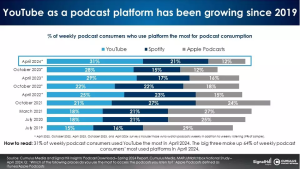
YouTube now requires disclosure of AI if it is used to make a real person say or so something they didn’t say, if footage of a real event is altered, or if a realistic scene is generated that did not actually occur. Both Spotify and Apple also have rules on AI use.
Video podcasting works in one of two ways – either having true video where there are talking heads or posting audio as a video by putting up a static image, which podcasters hope will lead to new listeners discovering their show. In addition, surveys show that minority populations want to see and well as hear their own communities.
Google data says that showing your face does help as 80% of the most successful video podcasts feature the host and get twice as many views as those podcast with only static images.
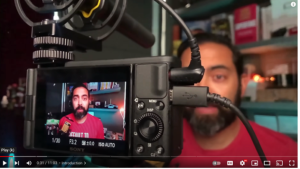

Since YouTube is owned by Google, the world’s biggest search engine, podcasters might see additional audience growth by adding video and could create a new revenue stream. In addition, YouTube is making a home for podcasts as Google shutdown their podcast app. Video may also attract an audience that doesn’t use podcast apps. However, you can also now listen to YouTube podcasts on YouTube Music and switch between audio-video versions for on-demand, offline, and background listening.
YouTube sought out established podcasters and created partnerships with NPR and Slate to bring over 20 top-performing podcasts to the platform. “Following the global success of our Tiny Desk Concerts, we are excited for our podcasts to reach new audiences on YouTube,” says Anya Grundmann, SVP of Programming and Audience Development at NPR. The New York Times also has a YouTube Channel. However, the strategy is not yet paying off with much of a jump in listenership, according to Bloomberg.

The Canadian Broadcasting Corporation (CBC) started its partnership with YouTube using artwork for a dozen audio podcasts into a new YouTube channel. They will expand to video podcasts with live elements.
ESPN has dozens of shows on YouTube, grouping them into topics by sport – such as basketball, soccer and MMA.
Spotify now lists over 100,000 video podcasts on its platform but that is only 2% of their total podcasts. The company is actively trying to get more video podcasts, with Spotify for Podcasters, replacing the podcast publisher Anchor. Executive Julie McNamera told The Verge “video podcasting is one of the fastest growing areas of podcasting, and we expect that growth to continue.” The company sees a growth in podcast consumption translating to more ad dollars.
Find tips on creating a video podcast from Resonate Studios and tips for how to do an audio and video podcast at the same time from Justin Jackson.
For creators, however, doing video is more complex, more expensive, and time-consuming to do well. While video works extremely well for Joe Rogan and other celebrities, for other podcasts the audience may not want to watch talking heads for very long.
Audience retention is the biggest reason to do audio, according to Pat Flynn, an entrepreneur and host of Smart Passive Income. He says if you are holding attention in video for minutes that you are doing pretty well, but in audio you can hold attention for 20 minutes or more and thus build a strong and trusting audience base.
Another strategy for video podcasts would be only to use video as a supplement to an audio-first podcast by taping a few video episodes but only uploading five-minute snippets of the show to YouTube to help attract an audience to the full audio episodes.
The good news for podcasting is that video podcasts are not replacing audio podcasts but instead providing another entry path to consuming content, according to several surveys including one by Signal Hill Insights of listeners in the U.S., Canada, and Australia. Independent podcasters are not flocking to video as YouTube is often used as a discovery tool by listeners.
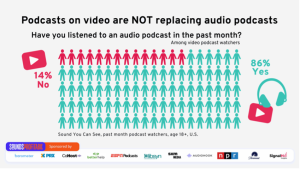
I remain an audio-only podcast listener because I thoroughly enjoy the art of audio storytelling and craft of sound design and want to get my eyes off screens. See Ch. 6 on Scripting to learn simple ways to add additional sound to enhance your storytelling episodes.
The social media app TikTok, with over 1 billion monthly users has added podcasts. Invitations about how to add podcast feeds to TikTok via RSS, have a message that says, “Viewers will be able to listen to your podcast episode from the linked videos.” Here’s some advice on how to promote your podcast using the app.
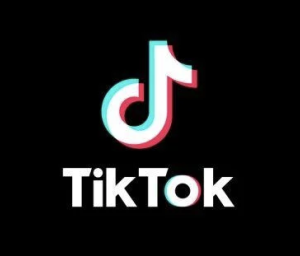
This comes at a time when the U.S. government, some states, local school districts, some colleges, and foreign governments banned TikTok use on official devices because of spying concerns over the Chinese-owned video sharing app.
Public opinion research finds that misinformation is eroding public confidence in democracy. In the aftermath of the January 6th insurrection, an NPR survey found that 6-in-10 Americans believe U.S. democracy is in crisis.
Still, the overwhelming majority of listeners believe the news they hear on podcasts according to a Pew study, which is a much higher level of trust than in other sources of news and information.
However, the podcast ecosystem can no longer escape scrutiny for playing a part in spreading false or misleading information. Spotify’s star podcaster Joe Rogan questioned the risks of vaccines for healthy young people and took lots of heat before he backtracked and said he’s “not an anti-vax person.” With more than 14 million listeners his reach is massive and influential. He hosted guests like far-right conspiracist Alex Jones and others who promoted coronavirus misinformation among other lies and it created lots of headaches for Spotify. The company subsequently pulled multiple episodes of “The Joe Rogan Experience.”
The Murky World of Political Podcasts
But the problem is bigger than Rogan according to Valerie Wirtschafter at The Brookings Institution, a non-partisan think tank in Washington, D.C. Her study of popular political podcasts concludes that one-tenth contain potentially false information. Since podcasts operate via RSS feeds, no federal license is needed so anyone can be a publisher/broadcaster. She calls the medium “an ideal tool to inject false or misleading information into the mainstream discourse while going undetected.”
The research found that 10 prominent podcasts were responsible “for the majority of the false and misleading content.” The hosts lean politically conservative and reach more than 28 million people on Facebook and Twitter. Steve Bannon’s War Room was found responsible for nearly 70% of conspiracy claims and a quarter of unsubstantiated COVID-claims.
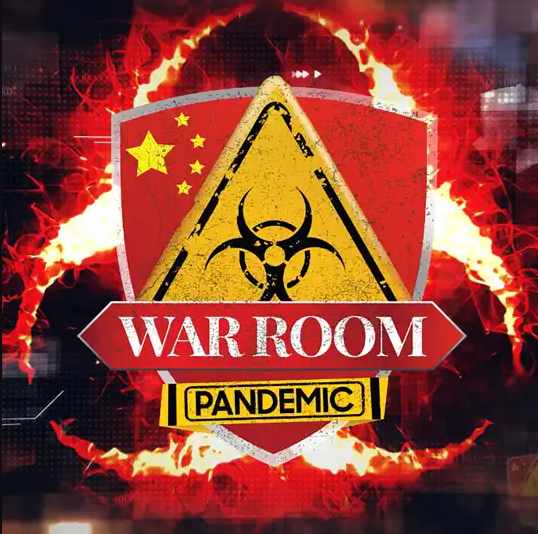 Brookings took the influence of podcasting on political discourse so seriously that they built a data tracker focused on political podcasts to better monitor the medium. You can look at weekly trends and users can build their graph by using filters. There are three times as many conservative-leaning shows as liberal-leaning ones, which is not surprising since hosts like Bannon are too extreme for mainstream media.
Brookings took the influence of podcasting on political discourse so seriously that they built a data tracker focused on political podcasts to better monitor the medium. You can look at weekly trends and users can build their graph by using filters. There are three times as many conservative-leaning shows as liberal-leaning ones, which is not surprising since hosts like Bannon are too extreme for mainstream media.
Podcasts resonate with diverse audiences – Black, Hispanic, and Asian populations, LGBTQ, people with disabilities, females, and younger audiences – and they are all looking for content that reflects their lived experience. Surveys show there would be even more listening if the podcast host reflected that diversity. Edison Research data shows the racial breakdown of monthly podcast listeners, “is almost identical to the spread of the U.S. population.”
iHeart Media as the largest audio company in the U.S. has multiple LGBTQ podcasts that cross cultures and ages with a far-reaching range of topics from gay history to sex, pop culture, transgender, and conversations with inspirational people in the LGBTQ+ community.


There is also an increasing number of podcasts about disability, with shows that are hosted and developed by the disabled. They provide transcripts for the deaf or hard-of-hearing and the growth of AI in easily creating transcripts creation is a big boost. If you use English, the Apple iPhone now offers live captions on podcasts and there are also live captions for some Android phones or on your computer if you use the Google Chrome browser. See Ch. 10 for transcribing resources.
 The Podcasting, Seriously Awards Fund supports independent BIPOC, Queer and Trans audio producers in submitting their work to media/journalism competitions with reimbursements up to $200 for awards and $500 in education/training.
The Podcasting, Seriously Awards Fund supports independent BIPOC, Queer and Trans audio producers in submitting their work to media/journalism competitions with reimbursements up to $200 for awards and $500 in education/training.

Other underrepresented voices are finding new opportunities in podcasting with opportunities for training, fellowships, mentoring, funding, professional trade organizations, and podcast conferences.
Since 2018, Spotify’s Sound Up Program has helped podcasters in underrepresented communities with “educational opportunities, resources, and access to industry experts.” The program is open in 12 markets, (Japan, Italy, the U.S., U.S. LatinX, India, Mexico, Australia, Sweden, the U.K., Germany, Brazil, and Argentina). Participants go through four weeks of training in storytelling, audio production, and workshop their ideas.
Now Spotify’s NextGen Audio Program, which showcases creators from underrepresented communities in the audio industry, has expanded to historically Black colleges and university(HBCU) campuses in the U.S., started with Spelman College in Atlanta, Georgia.
Women make up nearly half the podcast listening audience yet they remain a minority when it comes to podcast hosting. In recent years the podcast industry recognized the importance of this sizable audience by supporting programs to nuture podcast development and growth.
However, in 2023 that support took a hit as two major podcast festivals for women were postponed or canceled due to a lack of industry support and funding. The International Women’s Podcast Conference was canceled, but is now back in 2024, while the in-person She Podcasts conference was canceled and replaced with a virtual format but also returned in 2024. There are entrance fees but also some scholarships.
One bright spot came from Jar Audio, a full-service branded podcast agency. They introduced an emerging women podcaster competition. The winner’s ideas will result in a pilot episode.
The best hope for change might be the podcast networks that are now run by and for women.
Lemonada Media launched in 2019 as a woman-owned podcast network that produces content that “makes life suck less.” Cofounders Stephanie Wittels Wach and Jess Cordova Kramer connected after they both lost little brothers to opioid overdoses and wanted to give everyone a platform.
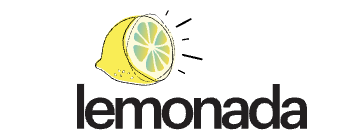
Lemonada shows are diverse, from Add to Cart with Kulap Vilaysack and SuChin Pak, to Blind Plea, a true-crime story about domestic abuse, and a show talking with older women, Wiser Than Me with Julia Louis-Dreyfus which was Apple’s Podcast of the Year in 2023.


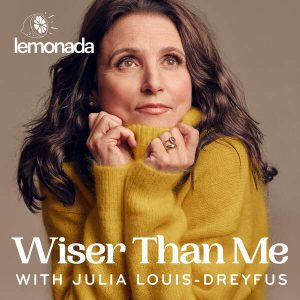
In the world of fiction, Emerald Audio is a premium podcast network with a female storytelling focus. “Fiction, particularly female-driven fiction, is at the very beginning of its growth in that area, and there are so many opportunities for strong, powerful stories aimed at women, says Co-founder and Bestselling author Jane Green. There will be a collection of nationally recognized storytellers.
There’s now some light at the end of the long, dark economic tunnel of 2023 where industry layoffs were significant at Spotify, NPR, Vox, Pushkin Industries, CNN, ESPN, PRX, iHeart Media, and the Los Angeles Times among others and there were also show cancellations.
The cuts happened due to rising capital costs, uncertain economic growth and demands for profitability. The good news is that podcast listenership and ad revenue are both growing. Although podcast ad revenue slowed in 2023, the year ended with increases of 5% to $1.9 billion, according to the Interactive Advertising Bureau, and is projected to have a growth rate of +12% this year.

Bloomberg’s Ashley Carmen writes that big deals do continue for proven hits like Joe Rogan, which is no longer exclusive to Spotify but available on all platforms. But the new deal is structured on revenue-sharing and podcasters must actively recruit advertisers and promote their shows.



Among the latest big deals in podcasting are with NFL stars Travis and Jason Kelce, who signed a three-year deal with Wondery for their podcast New Heights. The podcast network now owned by Amazon will sell ads on video and audio feeds in a deal over $100 million, along with licensing merchandise for the show that became a phenom after Travis began dating pop star Taylor Swift.
Satellite radio network SiriusXM also has a $100-million dollar deal with Call Her Daddy host, Alex Cooper, as well as another three-year mega-deal for Smartless with advertising, distribution rights, and events.
However, Adam Davison, who launched Planet Money in 2008, argues that the cost of making a big podcast show today has fundamentally changed from the boom days of rapid growth to a more mature industry.
Gone are the days when Spotify spent more than a billion dollars for exclusive content, studios, and big-name talent, fell flat. “The dumb money is gone, the easy money has slowed down, and the smart money has seen some pullback,” consultant and former NPR and Audible executive Eric Nuzum told Vanity Fair. It used to cost about half a million dollars to produce an eight-to-ten episode series but those budgets today have been slashed in half, promoting partnerships and consolidation among creators.
Today podcasting is a more mature industry, with companies being more selective in closing deals, or what some call ‘rightsizing.’ Producers are having to make do with far smaller budgets and it’s unclear how money will be spent on new programming.
A reminder that it was just after the 2007-2009 economic recession that some of the bigger podcasts today, such as WTF with Marc Maron and 99% Invisible, were created. Sarah Van Mosel, who was head revenue officer at the podcast network Stitcher, said “podcasting was born from adversity.” Van Mosel calls podcasts the “scrappy survivors” of the media industry. Stitcher is now owned by Sirius XM.
Looking ahead, Eric Nuzum wrote for NiemanLab that companies need to “dump revenue-based metrics as their primary goals,” and to focus instead on audience building. He says if there is a reboot to focus on building relationships with the audience, the money will follow.
The most active shows and largest audiences are produced by iHeartPodcasts and Wondery, according to monthly tracking of podcasts by Podtrac.

In 2024 Podtrac has now added the first global podcast rankings of top podcast publishers and networks as well as the first ranking to include YouTube views. Traditional metrics have focused only on the RSS distribution of podcasts. The inclusion of YouTube viewership “reflects worldwide multi-platform engagement, according to the analytics company, as well as measuring consumption beyond U.S. borders.
Podtrac has also put together the Top 10 Global Podcasts for 2024, based on global downloads and YouTube views.
